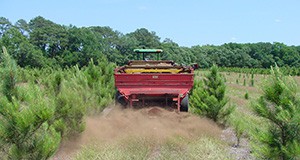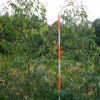
Pine straw has gained popularity as a mulch for residential and commercial landscaping in urban and suburban areas. It is attractive, relatively low-cost, and easy to work with. Best of all, it performs well in all kinds of locations–including those difficult-to-mulch slopes! Pine straw is perfect for water-efficient landscaping (xeriscaping), an increasingly popular choice for environmentally conscious landscapers. Thanks to the growing popularity of this natural mulch material, pine straw production has quickly become an important Florida industry. Regularly removing pine straw from pine stands is not without consequences, however; the loss of the cover and nutrients pine straw provides can reduce the productivity of the pine forest. Proper fertilization and harvest techniques are crucial to maintain the viability of the new industry and traditional pine industries alike. This 12-page guide written by Anna Osiecka, Patrick J. Minogue, and E. David Dickens and published by the School of Forest Resources and Conservation explains how to fertilize wisely to offset the effects of pine straw removal and maintain the viability of pine plantations.
http://edis.ifas.ufl.edu/fr395
Tag: Anna Osiecka
Herbicides for Weed Control in Eucalyptus Culture
 Eucalyptus is a diverse genus with over 700 species, most of which are native to Australia. Numerous Eucalyptus species and hybrid clones have been introduced in temperate climates throughout the world and grown as ornamental trees as well as for fuel and fiber. There is renewed interest in planting this fast-growing tree in the southeastern United States for mulch, pulpwood, and bio-energy. However, several silvicultural challenges exist, and competing vegetation control is a significant one. This 7-page fact sheet was written by Anna Osiecka and Patrick Minogue, and published by the UF Department of School of Forest Resources and Conservation, February 2013.
Eucalyptus is a diverse genus with over 700 species, most of which are native to Australia. Numerous Eucalyptus species and hybrid clones have been introduced in temperate climates throughout the world and grown as ornamental trees as well as for fuel and fiber. There is renewed interest in planting this fast-growing tree in the southeastern United States for mulch, pulpwood, and bio-energy. However, several silvicultural challenges exist, and competing vegetation control is a significant one. This 7-page fact sheet was written by Anna Osiecka and Patrick Minogue, and published by the UF Department of School of Forest Resources and Conservation, February 2013.
http://edis.ifas.ufl.edu/fr378
Forest Herbicide Characteristics (FOR283/FR345)
 The effectiveness and safe use of herbicides registered for forest vegetation management in Florida requires developing site-specific herbicide prescriptions made with careful consideration of site factors and knowledge of the chemical and physical properties of herbicides and their effects on biological systems. This 9-page fact sheet was written by Anna Osiecka and Patrick J. Minogue, and published by the UF Department of School of Forest Resources and Conservation, May 2011.
The effectiveness and safe use of herbicides registered for forest vegetation management in Florida requires developing site-specific herbicide prescriptions made with careful consideration of site factors and knowledge of the chemical and physical properties of herbicides and their effects on biological systems. This 9-page fact sheet was written by Anna Osiecka and Patrick J. Minogue, and published by the UF Department of School of Forest Resources and Conservation, May 2011.
http://edis.ifas.ufl.edu/fr345
Considerations for Developing Effective Herbicide Prescriptions for Forest Vegetation Management (FOR273/FR335)
Developing a herbicide treatment prescription is a complex process that involves matching a suitable herbicide program with a specific silvicultural operation and an overall management objective. This 8-page fact sheet reviews important considerations in developing effective and environmentally sound herbicide recommendations for managing vegetation in forests. It is intended for use by private forest land owners, foresters, and other land managers. Written by Anna Osiecka and Patrick J. Minogue and published by the UF Department of School of Forest Resources and Conservation, May 2011.
http://edis.ifas.ufl.edu/fr335
CIR1475/FR158 Herbicides Registered for Pine Management in Florida – 2008
Revised! Circular 1475, a 14-page fact sheet by Anna Osiecka, Patrick Minogue, Alan Long, Jarek Nowak, and Mark Mossler, provides comprehensive information about the herbicides currently registered for use in Florida pine plantations. Published by the UF School of Forest Resources and Conservation, February 2009.
http://edis.ifas.ufl.edu/FR158